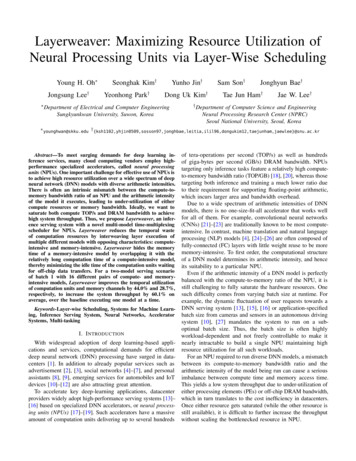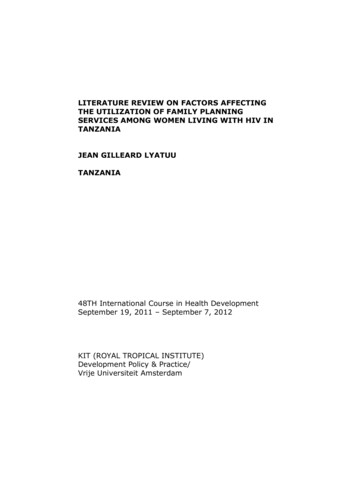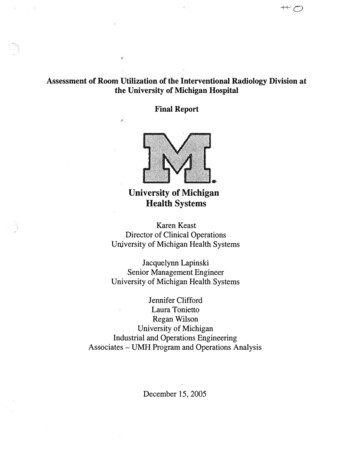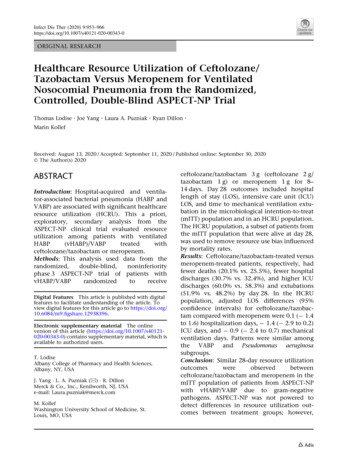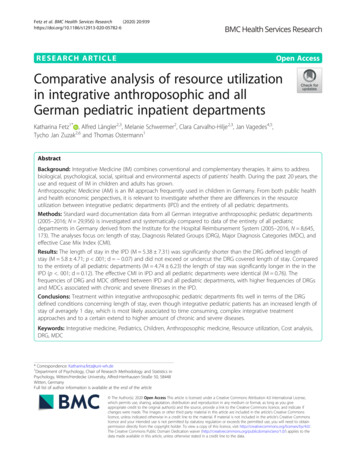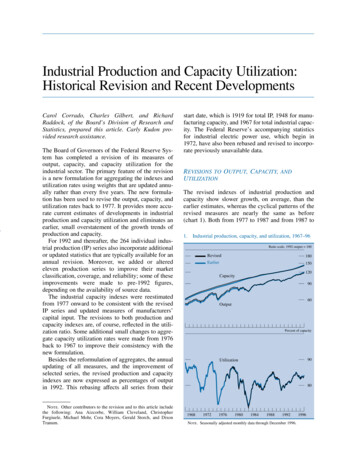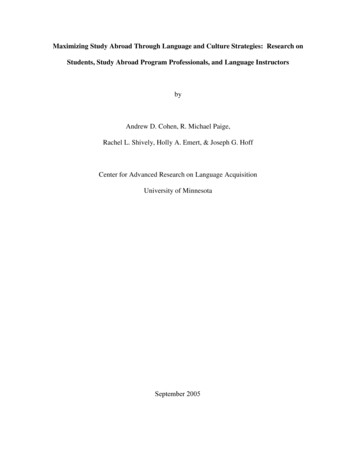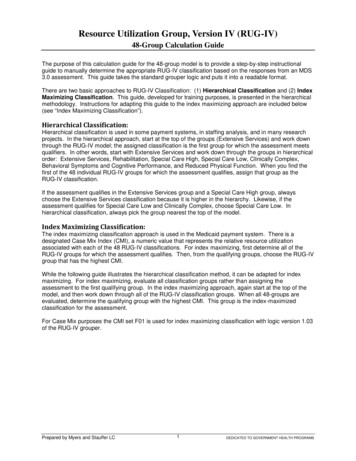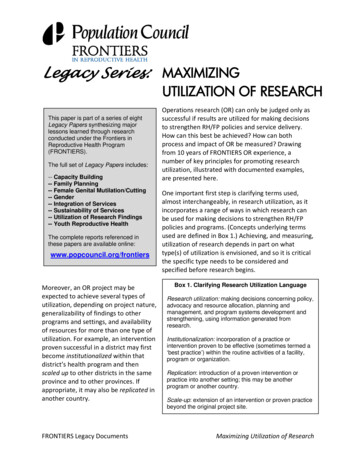
Transcription
Legacy Series: MAXIMIZINGUTILIZATION OF RESEARCHThis paper is part of a series of eightLegacy Papers synthesizing majorlessons learned through researchconducted under the Frontiers inReproductive Health Program(FRONTIERS).The full set of Legacy Papers includes:-- Capacity Building-- Family Planning-- Female Genital Mutilation/Cutting-- Gender-- Integration of Services-- Sustainability of Services-- Utilization of Research Findings-- Youth Reproductive HealthThe complete reports referenced inthese papers are available online:www.popcouncil.org/frontiersMoreover, an OR project may beexpected to achieve several types ofutilization, depending on project nature,generalizability of findings to otherprograms and settings, and availabilityof resources for more than one type ofutilization. For example, an interventionproven successful in a district may firstbecome institutionalized within thatdistrict’s health program and thenscaled up to other districts in the sameprovince and to other provinces. Ifappropriate, it may also be replicated inanother country.FRONTIERS Legacy DocumentsOperations research (OR) can only be judged only assuccessful if results are utilized for making decisionsto strengthen RH/FP policies and service delivery.How can this best be achieved? How can bothprocess and impact of OR be measured? Drawingfrom 10 years of FRONTIERS OR experience, anumber of key principles for promoting researchutilization, illustrated with documented examples,are presented here.One important first step is clarifying terms used,almost interchangeably, in research utilization, as itincorporates a range of ways in which research canbe used for making decisions to strengthen RH/FPpolicies and programs. (Concepts underlying termsused are defined in Box 1.) Achieving, and measuring,utilization of research depends in part on whattype(s) of utilization is envisioned, and so it is criticalthe specific type needs to be considered andspecified before research begins.Box 1. Clarifying Research Utilization LanguageResearch utilization: making decisions concerning policy,advocacy and resource allocation, planning andmanagement, and program systems development andstrengthening, using information generated fromresearch.Institutionalization: incorporation of a practice orintervention proven to be effective (sometimes termed a‘best practice’) within the routine activities of a facility,program or organization.Replication: introduction of a proven intervention orpractice into another setting; this may be anotherprogram or another country.Scale-up: extension of an intervention or proven practicebeyond the original project site.Maximizing Utilization of Research
Most of the principles described below are relevant whether research concernsintroduction of a new or improved RH/FP technology to a country or program (such asemergency contraception), or of a new / revised service delivery guideline or tool (such asthe Balanced Counseling Strategy or Systematic Screening or an educational or trainingcurriculum), or the reorganization of service delivery systems (such as integrating FP withHIV services, or using community‐level workers to provide services usually offered inclinics).Communicating Results to Influence DecisionsUnderlying all research utilization is communication of information generated by those whoproduce it to those who can use it for making decisions. FRONTIERS experience suggests anumber of strategies can enhance likelihood this communication can be effective.Translate and synthesize. Research, like servicedelivery, has its own vocabulary that can bedifficult for non‐researchers to understand.Moreover, the types of action decisions thatcould be made based on findings should beexplicitly stated as recommendations; simplypresenting research findings requires thedecision‐maker to interpret them, which mayresult in wrong decisions. Bringing together arange of evidence from several researchstudies can greatly strengthen findings.Documents such as the FRONTIERS series ofProgram Briefs (Box 2) are examples of howresearch findings can be translated andsynthesized to produce programmaticallyuseful information.Communicate results through multiplechannels to reach the same audiencemany times and many audiences at leastonce. Hearing the same message many timesand from different sources increaseslikelihood it will be used. Communicating thesame findings in Final Reports, OR Summaries(www.popcouncil.org/frontiers/pubs types/orsummaries/ors.html), Program Briefs,national workshops, internationalconferences, listserv announcements,interpersonal discussions and other forms ofmedia has increased visibility of key findingsfrom FRONTIERS projects.FRONTIERS Legacy DocumentsBox 2. FRONTIERS Program BriefsFRONTIERS produced 13 Program Briefs, 4- to20- page documents that synthesized findingsfrom OR on major reproductive health issues,online at:www.popcouncil.org/frontiers/pubs types/prbriefs.html1. Meeting women’s needs after abortion2. Using men as community-baseddistributors of condoms3. Enhancing quality for clients: Thebalanced counseling strategy4. Postabortion family planning benefitsclients and providers5. Building capacity to utilized operationsresearch6. Systematic screening: A strategy fordetermining and meeting clients’reproductive health needs7. Make better use of provider time inpublic health clinics8. How much will it cost to scale up areproductive health pilot project?9. Increasing women’s use of the IUD forfamily planning10. Meeting the family planning needs ofpostpartum women11. Adapting focused antenatal care:Lessons from three African countries12. Financial capacity building for NGOsustainability13. Multisectoral youth interventions: Thescale-up process in Kenya and SenegalMaximizing Utilization of Research
Share results with specialist ‘mediator’ organizations. Recognizing the need for research‐based evidence and difficulties faced by most researchers in effectively communicatingprogrammatic messages from findings, a number of specialist organizations and projectsnow exist that can assist in communicating findings (Askew, Matthews, and Partridge 2006).Examples include the Population Reference Bureau, the Johns Hopkins Center forCommunications Programs, and the “C‐Change” project, among others. A particularly usefulmediator for RH/FP programming is the “Implementing Best Practices” initiative,coordinated by WHO (Box 3).Box 3. The IBP InitiativeInitiated by WHO and USAID and with supported by numerous international agencies, the IBPInitiative seeks to improve access to evidence-based practices in reproductive health. Thecoalition supports country and regional conferences focused various issues, from identifying bestpractices on a specific topic to scaling up proven practices throughout the health care system.The IBP initiative has produced guidelines on the scale-up process, and also operates a“Knowledge Gateway” to circulation of documents on best practices and discussion of fieldexperiences. The Knowledge Gateway offers community discussions on a range of topics, acommunity library, announcements, and a calendar of events. www.ibpinitiative.orgBecome a decision‐maker. One extremely effective way to communicate findings is forresearchers themselves to engage in decision‐making processes. Researchers can playextremely useful roles when serving on committees, steering groups, technical advisorygroups, program design teams, etc. by bringing not only information from their ownresearch but also a thorough understanding of literature around the topic.Managers also have a responsibility to seek out research‐based information. The onuson communicating research results is usually placed on those producing information.However, a decision‐maker has to want to use such information, must know how to find it,and should actively search for it. FRONTIERS addressed this issue in a number of ways,including developing a short course on OR specifically tailored for managers (Box 4),engaging nationaldecision‐makers inBox 4. OR for Managersdesigning andThis three-day course is one of several introductory coursesimplementing ORon OR developed by FRONTIERS. The OR for Managers course isprojects, supportingdesigned to educate managers of reproductive health and serviceprovision programs on operations research and how to applyparticipation atresearch findings to improve programs.research conferences,www.popcouncil.org/frontiers/OR Course/index.htmand soliciting theirperspectives onForeit and Khan 2008research priorities.FRONTIERS Legacy DocumentsMaximizing Utilization of Research
Strategies for Increasing Research UtilizationWhile it is both impossible and inappropriate to propose a standardized model fordeveloping and implementing OR to maximize utilization, experience from almost 200projects over 10 years has provided FRONTIERS with many examples of what does and doesnot work. This experience has been combined with WHO’s and other partners’ experiencesin “Turning Research into Practice” (Box 5). FRONTIERS also collaborated with several UK‐based DFID‐funded applied research groups, which provide another rich source of guidanceon maximizing research utilization (Askew, Matthews, and Partridge 2006; Nath 2007). TheMEASURE Evaluation Project’s ‘Data Demand and Information Use’ initiative also offers auseful framework and several tools for ensuring research can inform program decisionmakers (Foreit et al. 2006). Some of the key strategies emerging from these reviews follow.Plan for utilization BEFORE starting research.Managers and researchers must consider long‐term prospects for research before obtainingfunding and even before writing researchproposals. Planning needs to address severalquestions: Who will use the data? Whatdecisions can be influenced? Can they committhemselves to making and funding changesneeded?Engage and work with data users and otherstakeholders throughout researchprocess. Involve those who will use the data(managers, clinicians, policymakers) inresearch design to find out what type of datawould be most persuasive and effective. Giveregular progress reports (in person andwriting) and encourage managers to make sitevisits. Work with them to interpret draftresults before finalizing the study so they canunderstand and identify programmaticimplications.Undertake operations research in a favorablecontext. Valid measures of feasibility andeffectiveness can only be achieved when anintervention is fully implemented. Thus it ispreferable to select project sites from amongthose that are stable, functioning, and readyto deliver intervention.FRONTIERS Legacy DocumentsBox 5. TRIP Report: A frameworkfor maximizing research utilizationThis report is the product of two internationalmeetings in which researchers,policymakers, donors, and programmanagers developed guidance on increasethe use of research findings in programdevelopment and monitor the incorporationof evidence-based practices withinreproductive health ns/trip/index.htmlMaximizing Utilization of Research
Use the strongest research design and data collection methods possible. Fullyexperimental designs are not always possible, but strong quasi‐experimental designs shouldbe used wherever possible. Adhering to national and international ethical standards forresearch must be a priority, even if it compromises ideal study design. Be careful not tocollect too much data; be guided by types of programmatic decisions you would like data toinform.Analyze data quickly and prioritize results needed for decisions. Keep initial analysissimple, yet appropriate. Involve decision‐makers in data analysis and interpretation sofindings can be translated into actionable statements or policies. Prioritize communicationof findings to decision‐makers most likely to use findings and to communities participatingin studies first.Plan for, budget for, and include “utilization” phase within research process.OR strengthening service delivery should not end with results dissemination to decision‐makers; it is unreasonable to expect them to simply turn findings into action. Resourcesshould be leveraged so those who undertook pilot project can provide technical assistanceto help programs implement changes indicated by research findings.Only recommend and advocate for service delivery changes if results really dodemonstrate feasibility, effectiveness (and preferably cost‐effectiveness), andpotential for institutionalization and scale‐up. Research data can be misunderstood ormisused—for example, to support particular viewpoints. Great care is needed to avoidrecommending interventions be adopted when data does not really demonstrateconvincing effectiveness, as well as approaches to service delivery being changed unlessalternatives really are more effective or less costly.Institutionalization of Proven Practices: Critical Step in Creating Conditions forScaling Up Effective InterventionsTechnical assistance is not usually conceptualized as a “research” activity. However, afterresearch has identified a promising practice, a follow‐on phase of technical assistance is aneffective strategy for enhancing institutionalization of a new practice prior to full scale‐up.During this follow‐on phase, individuals or organizations who undertook the pilot projectprovide support to help the RH/FP program enact changes necessary to institutionalize thepractice, so it becomes routine. Within FRONTIERS, this adaptation phase was organized asand termed a “creating conditions for scale‐up” project. These projects lasted from six to 18months depending on the adaptations needed, and could include activities such asreorganizing staff responsibilities and skills training in new procedures, revising trainingcurricula, changing supervisory procedures, restructuring recordkeeping and reportingforms, and so on.FRONTIERS Legacy DocumentsMaximizing Utilization of Research
To ensure interventions proven effective during pilot projects can be institutionalized intoprogram routine operating procedures, “creating conditions” projects support expansion ofprocedures throughout all facilities in one or more districts – and usually district(s) in whichthe intervention was piloted. In most countries of Africa and South Asia, the district is thelowest level of health services administration; consequently, these projects providetechnical assistance to staff of a district health management team (or its equivalent) byhelping comprehensively institutionalize new or improved practices—that is, within districtplanning, budgeting, implementation, and reporting systems. Experience has shown thisphase of limited scale‐up of proven practices demonstrates the intervention can beincorporated into and funded by existing health systems, institutionalized into routineprocedures, implemented at scale, and funded by the health program.This phase has proven critical for an RH/FP program to learn how to perform thesefunctions before more widespread scale‐up can be undertaken. Examples of “creatingconditions” projects include: a male RH services model in Bangladesh (Mannan et al. 2008); aQuality Assurance approach in Gujarat State, India (Khan et al. 2008); a model for involvingmen in maternity care in New Delhi, India (Varkey, Mishra, and Khan 2008); and communitymidwifery services in Western Province, Kenya (Mwangi and Warren 2008).Scaling up best practices: Effectiveness, efficiency, and expansionThere are many reasons why pilot projects showing how to effectively implement new andimproved practices are not scaled up, including limited funding (availability for duration ofresearch project only); lack of expectation by donor those implementing pilot project shouldscale up practices tested; and an assumption service delivery organizations are able to takeresearch findings and scale them up in an RH/FP program. Introducing a “creatingconditions” phase enables programs to move from providing services effectively to learninghow to provide them efficiently, by adapting new practices to existing district‐level systems.Scaling‐up from district level to regional or provincial, and then national levels, requiresanother phase: learning how to expand responsibility to institutionalize service deliveryprotocols throughout the service delivery program.FRONTIERS experience with nationwide scale‐up of emergency contraception (EC) servicesin Bangladesh (Khan and Hossain Forthcoming) and of expanding an adolescent RH services inKenya (Evelia et al. 2008; Joyce et al. 2008) provide two examples of ways in which programshave learned to expand implementation of interventions proven effective and efficient.Some general lessons emerging from these two experiences include:9 Ensuring the government ministry or ministries lead the process, not just in title but bydesignating key managers to make all relevant decisions;9 Convincing the government to commit funding to sustain new way of providing services,whether from internal commitments or negotiations with development partners;FRONTIERS Legacy DocumentsMaximizing Utilization of Research
9 Engaging a wide range of national andinternational stakeholders to appearnot to advocate for one organization’sinterests;9 Supporting policy and systems reviewsand revisions facilitating nationwideimplementation of new services andprocedures;9 Creating a training cascade throughtraining of trainers at several levels tominimize resources needed.An important lesson, for both those con‐Guidance for adapting and modifying costducting a pilot project and for thoseinformation obtained from a pilot project toresponsible for scale‐up, is testing and imple‐estimate scale-up costs is provided inmenting only interventions a national programFRONTIERS Program Brief no. 8 (Janowitz, Bratt,can afford to scale up. There is no point inHoman, and Foreit 2007). The brief shows why thecosts of a pilot project alone are not sufficient topilot‐testing interventions not affordable atpredict costs of scale-up, and gives examples ofscale. When designing a pilot project, plannershow costs are influenced by factors likeshould attempt to estimate costs of scaling upeconomies and diseconomies of scale, resourcebefore embarking on ‘creating conditions’ andsubstitution, and intervention modification.‘expansion’ phases. In so doing, wasteassociated with piloting unsustainableinterventions can be avoided. Affordable interventions may produce less spectacular resultsduring the pilot phase, but being able to scale up more modest, affordable interventions willmake larger health impacts than small‐scale projects yielding large health benefits but only inintensively‐resourced pilot projects –so‐called ‘boutique’ projects.Replicating Successful InterventionsAn intervention that is proven effective and efficient in one setting can be attractive toprograms in other countries. An effective strategy to facilitate replication is to hold aworkshop or conference, attended by policymakers and program managers from severalcountries in a region, at which practical guidance in introducing and scaling‐up a provenbest practice is provided by those responsible for successfully piloting the intervention.FRONTIERS used this strategy to replicate several of the interventions initially testedthrough OR projects.In 2002 FRONTIERS joined a consortium of international organizations in Senegal to convenea regional conference that advocated for increasing access to and strengthening quality ofpostabortion care (PAC) services (Postabortion Care (PAC) Initiative for Francophone AfricaCommittee 2004) (Box 6). Two key presentations were the experiences of Senegal andBurkina Faso in developing and testing PAC interventions through OR projects (Askew 2006).FRONTIERS Legacy DocumentsMaximizing Utilization of Research
These systematically documented pilot projectsformed the basis of the model developed forintroducing PAC services in other countries in theregion. An analysis of the experiences ofintroducing PAC into four other countries(Guinea, Mali, Niger and Togo) and of scaling upthe pilot experiences in Burkina Faso and Senegalby the Centre de Formation et de Recherche enSanté de la Reproduction (Center for Training inReproductive Health Research or CEFOREP)describes the processes followed in the region(see box).Box 6. Replicating PACin West AfricaIn this model emphasis was placed onidentification of national champions,advocacy to gain support for PACservices, need for an initially verticalprogram, a pilot phase using anoperations research approach, andtraining of trainers. During this sixcountry assessment, these elementswere highlighted as key determinantsby national stakeholders. In particular,the role of an initial OR study andutilization of findings and leadership ofuniversity professors as facilitatingfactors for PAC introduction was highlyinfluential. The assessment identified22 programmatic recommendations forguiding replication of this PAC model.FRONTIERS used this strategy to replicateintroduction of a gender accreditation tooldeveloped and scaled‐up in Bolivia (Palenque et al.2004; Palenque, Riveros‐Hamel, and Vernon 2007). InDieng et al. 2008June 2007 a workshop in Costa Rica trained 31participants in the strategy from Ministries ofHealth, Social Security Institutes, multilateral organizations and several NGOs in Bolivia,Peru, Ecuador, Dominican Republic, El Salvador, Honduras, Guatemala, and Costa Rica.Subsequently, technical assistance was provided to organizations in El Salvador, Hondurasand Peru to support introduction of the tool (Riveros‐Hamel, Martin, and Vernon 2008).The same strategy has also been used recently in collaboration with WHO’s Africa RegionalBureau for replicating a multisectoral adolescent RH model in several African countries(Burkina Faso, Ghana, Kenya, Mauritania, Mozambique, Namibia, Senegal, Tanzania, andZimbabwe) (Diop and Diagne 2008), and for enhancing postpartum/postabortion familyplanning services in the Arab region (Egypt, Jordan, Sudan, and Yemen) (FRONTIERS 2008).Evaluating OR UtilizationAs with service delivery projects, evaluating operations research activities has many benefits:9 Increasing recognition of value of evidence‐based policy making and servicesprogramming;9 Demonstrating to funder research is “making a difference” and is therefore aworthwhile investment;9 Justifies allocation of resources and prioritizes future allocations;9 Focuses researcher attention on utilization and application of research findings;9 Helps improve design and implementation of research, thereby increasing likelihood ofproducing results than can be utilized.FRONTIERS Legacy DocumentsMaximizing Utilization of Research
A number of ways have been tested to measure and document research utilization.The case‐study approach reviews utilization of a specific OR activity in great depth tounderstand whether findings were used, and if so, how. The “Getting Research into Policyand Practice” (GRIPP) initiative collected 18 case studies, documented researcher activitiespromoting utilization, and created a web portal for communicating experiences. GRIPP wasa partnership between FRONTIERS, John Snow International (Europe), and two DFID‐fundedresearch programs, Opportunities and Choices and Safe Passages to Adulthood. A synthesisof the 18 case studies identified a number of factors facilitating utilization (Nath 2007). Thecase study approach requires documentation be integral to the research process frominception, a neutral facilitator document the process, adequate resources budgeted fordocumentation, and identification of appropriate stakeholders to elicit differentperspectives.A second approach reviews a broad portfolio of research initiatives undertaken in aparticular setting to learn about underlying patterns facilitating or obstructing researchutilization. Such an approach has been used in Mexico and Guatemala, Bangladesh,Indonesia, and Egypt. In Mexico, the focus was on describing the relationship betweenhealth researchers and policy makers and “to reconstruct the processes through whichresearch was used to make decisions and policies” (Trostle 2006). In Guatemala, researchersreviewed 44 OR projects conducted by the Population Council between 1988 and 2001(Brambila et al. 2007). Projects were on a wide range of topics, covered different targetgroups, and were conducted with diverse collaborating institutions and researchers. Thisapproach has previously been used in Bangladesh (Hagga and Maru 1996), Egypt (Hegazi 1997)and Indonesia (Iskandar and Indrawati 1996).A third approach generates quantitative measures of the extent to which lessons from an ORproject have been used. Tulane University developed a methodology for assessingutilization of FRONTIERS projects that collected data on 14 process indicators (level ofparticipation of key stakeholders, quality of research, problems in program implementation)and 11 impact indicators (Box 7), and sixcontextual factors (e.g. facilitating factors,Box 7. Key Impact Outcomesbarriers, assessment of costs) (Marin and BertrandMeasured by Tulane Methodology:2000; Marin, Gage, and Khan 2004). This1. Were improvements made tomethodology evaluated the extent of utilizationprogram?2.(If proven effective) were theof 64 FRONTIERS projects that had tested animprovementsscaled up?intervention between 1998 and 2004 (RamaRao3. (If proven successful) were theand Golon 2005). The Tulane methodology is easyimprovements replicated?to use, fairly low‐cost and generates quantitative4. Was policy (re-) formulated?5. Was increased funding madeindicators, making it attractive to those fundingavailable?research programs. For more textured process6. Was organizational capacityinformation, this methodology can beenhanced?complemented by case studies and portfolioreviews.FRONTIERS Legacy DocumentsMaximizing Utilization of Research
type(s) of utilization is envisioned, and so it is critical the specific type needs to be considered and specified before research begins. Box 1. Clarifying Research Utilization Language. Research utilization: making decisions concerning policy, advocacy and resource allocation, planning and
